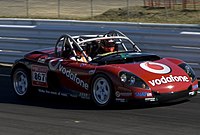
The Société des Automobiles Alpine SAS, commonly known as Alpine, is a French manufacturer of sports cars and racing cars established in 1955. The Alpine car marque was created in 1954.
Caterham Cars Ltd. is a British manufacturer of specialist lightweight sports cars established in Caterham, England, with their headquarters in Dartford, England. Their current model, the Caterham 7, originally launched in 1973, is a direct evolution of the Series 3 Lotus Seven designed by Colin Chapman. In the 1990s the company made the Caterham 21, a two-seater soft top alternative to the MGF and Lotus Elise,. A track-only car, the SP/300.R, a joint project with Lola was released for customer testing in 2010 and was scheduled for release in 2013.
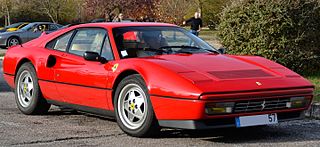
The Ferrari 328 GTB and GTS are mid-engine V8, two-seat sports cars created by Italian automobile manufacturer Ferrari. It was the successor to the Ferrari 308 GTB and GTS. While mechanically still based on the 308, modifications were made to the body, chassis, and engine, most notably an increase in engine displacement to 3.2 L for increased power and torque output. The 328 is still considered by some enthusiasts to be one of the most reliable and functional Ferraris; unlike other models, much of its maintenance can be performed without lowering the engine from the vehicle. In 1989, the 328 was succeeded by the 348.
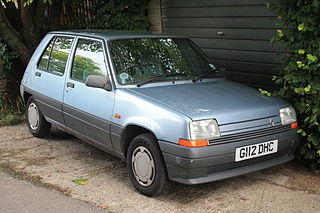
The Renault 5 is a five-passenger, three or five-door, front-engine, front-wheel drive hatchback supermini manufactured and marketed by the French automaker Renault over two generations: 1972–1985 and 1984–1996. The R5 was marketed in the US and Canada as Le Car, from 1976 until 1983. Renault marketed a four-door sedan variant, the Renault 7, manufactured from 1974 until 1984 in Spain by Renault's subsidiary FASA-Renault and exported to select markets.

The Porsche 997 is the sixth generation of the Porsche 911 sports car manufactured and sold by the German automobile manufacturer Porsche between 2004 and 2013. Production of the Carrera and Carrera S coupés began in early 2004, all-wheel drive Carrera 4 and Carrera 4S began to be delivered to customers in November 2005, the Turbo and GT3 derivatives went on sale in late 2006 and the GT2 in 2007. In addition to the coupé and cabriolet versions, Targa versions of the Carrera 4 and Carrera 4S were also available, which carry on with the "glass canopy" roof design used since its first application on the 993 until the 991, which reverted to the classic targa top layout used on the early 911 Targas.

The DFV is an internal combustion engine that was originally produced by Cosworth for Formula One motor racing. The name is an abbreviation of Double Four Valve, the engine being a V8 development of the earlier four-cylinder FVA, which had four valves per cylinder.

The Renault 5 Turbo or R5 Turbo is a sport hatchback automobile launched by the French manufacturer Renault at the Brussels Motor Show in January 1980. The car was primarily designed for rallying, but was also sold in a street version.
Renault Sport or Renaultsport, was the motorsport, performance and special vehicles division for Renault-badged cars and is now a sub-badge of Renault cars managed by Alpine. Renault Sport was officially established in 1976 as a merger between the Alpine and Gordini competition departments. It was reorganised in 2002 and 2016. In December 2021, all Renault Sport operations were merged into an Alpine-led business unit. The Renault Sport car range under Alpine is set to be almost completely phased out by the end of 2023.

The Alpine A110 is a sports car produced by French automobile manufacturer Alpine from 1963 to 1977. The car was styled as a "berlinette", which in the post-WWII era refers to a small enclosed two-door berline, better-known as a coupé. The Alpine A110 succeeded the earlier A108. The car was powered by a succession of Renault engines. A car also named Alpine A110 was introduced in 2017.
The Renault Alpine GTA and the succeeding A610 is a sports coupe automobile produced by the Renault-owned French manufacturer Alpine between late 1984 and 1995. It replaced the slow-selling Alpine A310, with which it shared many features, including the layout and engine. The GTA was replaced by the A610 in 1991.

Formula Renault are classes of formula racing popular in Europe and elsewhere. Regarded as an entry-level series to motor racing, it was founded in 1971, and was a respected series where drivers can learn advanced racecraft before moving on to higher formulas.
The Alfa Romeo Tipo 33 was a sports racing prototype raced by the Alfa Romeo factory-backed team between 1967 and 1977. These cars took part for Sport Cars World Championship, Nordic Challenge Cup, Interserie and CanAm series. A small number of road going cars were derived from it in 1967, called Alfa Romeo 33 Stradale.
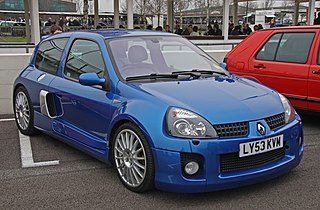
The Renault Clio V6 Renault Sport is a rear mid-engine, rear-wheel-drive layout sport compact based on the Renault Clio launched in 2001. Designed by French automaker Renault the Phase 1 models were built by Tom Walkinshaw Racing (TWR) in Uddevalla, Sweden and Phase 2 were designed and hand built by Renault Sport in Dieppe, France. Both variants were developed by TWR. The mid-engined, wide-body concept of the Clio V6 was very reminiscent of the 1980s Renault 5 Turbo. Both road going models were low volume production making them very rare cars. Alongside the road car, a circuit only version was produced, known as the Clio V6 Trophy. This was a full competition car, with sequential Sadev gearbox, full roll cage, magnesium wheels and engine output upped to 285 PS.

The Renault Mégane Renault Sport is a series of high-performance hatchback models based on the Renault Mégane, produced since 2004 by the high-performance subsidiary company Renault Sport for its parent company Alpine, a subsidiary of Renault. The Mégane RS won awards such as "Best hot hatch" from What car? (2010–2014), "Highest placed non-supercar" in Evo's annual Car of the Year test 2011 and "Best hot hatch" from Top Gear.
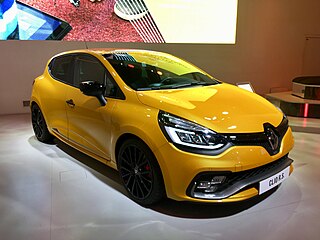
The Clio Renault Sport is a hot hatch produced by Renault Sport since 1998, the high-performance division of French automaker, Renault. It is based on the Clio supermini.

F Renault engine is an automotive internal combustion engine, four-stroke, inline-four engine bored directly into the iron block, water cooled, with overhead camshaft driven by a timing belt, and with an aluminum cylinder head, developed and produced by Renault in the early '80s, making its appearance on the Renault 9 and 11. This engine is available in petrol and diesel versions, with 8 or 16 valves.

The ALFA 24 HP is a 4.1-litre four-cylinder passenger car, the first model produced by Italian car manufacturer ALFA, which in 1919 would become Alfa Romeo. It was introduced in 1910, the year ALFA was founded, and produced until 1914 in ALFA's Portello factory near Milan. The model's name comes from its tax horsepower rating, then frequently used as vehicle designation.
This article gives an outline of Formula One engines, also called Formula One power units since the hybrid era starting in 2014. Since its inception in 1947, Formula One has used a variety of engine regulations. Formulae limiting engine capacity had been used in Grand Prix racing on a regular basis since after World War I. The engine formulae are divided according to era.

The Renault Clio Cup Series is a one-make racing series created and managed by Alpine Racing. The championship was born after merging the 4 active Renault Clio national cups at that moment plus the Clio Cup Europe.

The Porsche 911 is a two-door 2+2 high performance rear-engined sports car introduced in September 1964 by Porsche AG of Stuttgart, Germany. It has a rear-mounted flat-six engine and originally a torsion bar suspension. The car has been continuously enhanced through the years but the basic concept has remained unchanged. The engines were air-cooled until the introduction of the 996 series in 1998.





